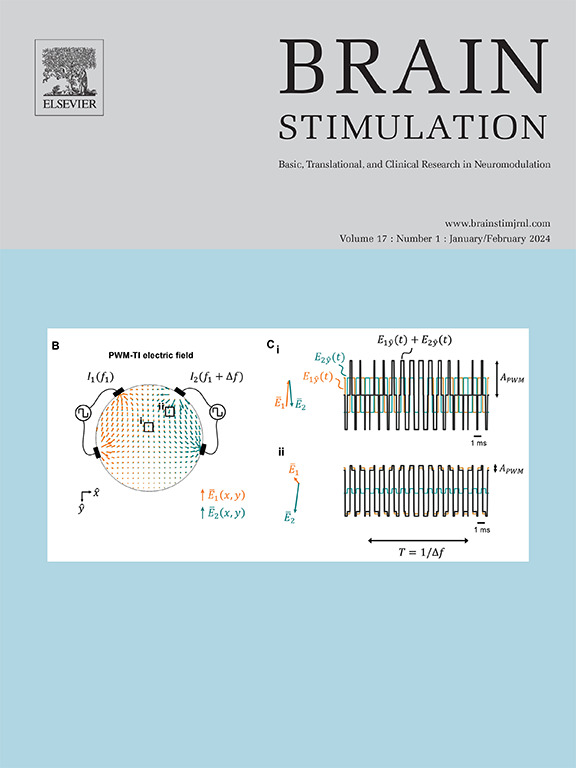重复磁刺激通过突触前和突触后的协同活动诱导兴奋性突触的可塑性
IF 8.4
1区 医学
Q1 CLINICAL NEUROLOGY
引用次数: 0
摘要
经颅磁刺激(TMS)是一种广泛应用的非侵入性技术,但其细胞和分子机制尚不完全清楚。目前的协议在很大程度上是启发式的,基于系统级观察。本研究通过结合体外模型和计算模拟,探讨了10hz重复磁刺激(rMS)如何诱导突触可塑性。材料和方法将小鼠器官型脑组织培养物暴露于10 Hz rMS(900脉冲)下。电生理学、光遗传学和化学遗传学工具评估了突触可塑性机制。基于峰值时间依赖性可塑性(STDP)的计算模型预测刺激结果,药理干预测试了脑源性神经营养因子(BDNF)/原肌球蛋白受体激酶B (TrkB)信号传导的作用。结果与电刺激和光遗传刺激一样,10 Hz rMS通过突触前和突触后协调激活增强兴奋性神经传递,其中BDNF起关键作用。计算模型准确地预测了频率相关的影响。阻断BDNF/TrkB信号可阻止rms诱导的增强,而TrkB激活可将电诱导的LTD转化为LTP。结论这些发现支持了STDP和BDNF/TrkB信号在rms诱导的突触变化中的机制作用,为未来的实验、计算和潜在的临床研究奠定了基础。本文章由计算机程序翻译,如有差异,请以英文原文为准。
Repetitive magnetic stimulation induces plasticity of excitatory synapses through cooperative pre- and postsynaptic activity
Introduction
Transcranial magnetic stimulation (TMS) is a widely used non-invasive technique, yet its cellular and molecular mechanisms remain incompletely understood. Current protocols are largely heuristic, based on system-level observations. This study explores how 10 Hz repetitive magnetic stimulation (rMS) induces synaptic plasticity by integrating in vitro models with computational simulations.
Materials and methods
Mouse organotypic brain tissue cultures were exposed to 10 Hz rMS (900 pulses). Electrophysiology, optogenetic and chemogenetic tools assessed synaptic plasticity mechanisms. Computational modeling based on spike-timing-dependent plasticity (STDP) predicted stimulation outcomes, and pharmacological interventions tested the role of brain-derived neurotrophic factor (BDNF)/tropomyosin receptor kinase B (TrkB) signaling.
Results
Unlike electrical or optogenetic stimulation, 10 Hz rMS enhanced excitatory neurotransmission via coordinated pre- and postsynaptic activation, with BDNF playing a crucial role. Computational modeling accurately predicted frequency-dependent effects. Blocking BDNF/TrkB signaling prevented rMS-induced potentiation, while TrkB activation converted electrically induced LTD into LTP.
Conclusion
These findings support a mechanistic contribution of STDP and BDNF/TrkB signaling to rMS-induced synaptic changes, providing a foundation for future experimental, computational and potentially clinical investigations.
求助全文
通过发布文献求助,成功后即可免费获取论文全文。
去求助
来源期刊

Brain Stimulation
医学-临床神经学
CiteScore
13.10
自引率
9.10%
发文量
256
审稿时长
72 days
期刊介绍:
Brain Stimulation publishes on the entire field of brain stimulation, including noninvasive and invasive techniques and technologies that alter brain function through the use of electrical, magnetic, radiowave, or focally targeted pharmacologic stimulation.
Brain Stimulation aims to be the premier journal for publication of original research in the field of neuromodulation. The journal includes: a) Original articles; b) Short Communications; c) Invited and original reviews; d) Technology and methodological perspectives (reviews of new devices, description of new methods, etc.); and e) Letters to the Editor. Special issues of the journal will be considered based on scientific merit.
 求助内容:
求助内容: 应助结果提醒方式:
应助结果提醒方式:


